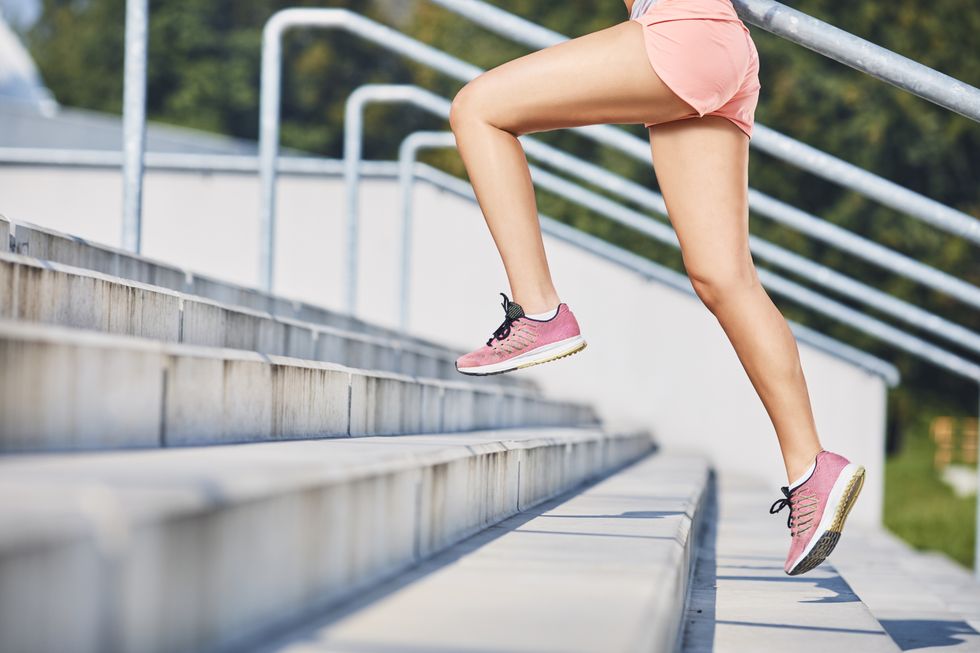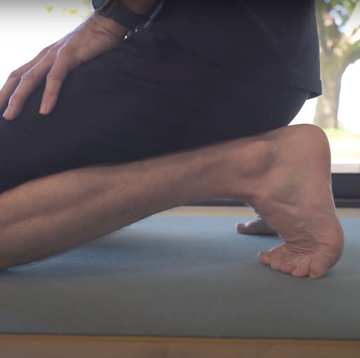Your calves and shins may not have the complex construction or delicate reputation of your knees and feet, but that doesn’t mean they’re indestructible. In a recent survey of 14,000 injured runners, sports podiatrist Stephen M Pribut found that calf pulls were the second most common complaint, with shin splints coming in fourth.
What are calf pulls?
Anyone who runs on hard surfaces, trains in worn-out shoes, rapidly racks up mileage or neglects stretching and strengthening the lower leg is at risk, according to Pribut, who treats runners in Washington DC in the USA.
Your calves lift the heels about 1,500 times every mile, and your shins support the arches, raise the toes and absorb impact. Because the propulsive motion of running works the rear of the leg more than the front, runners often have overworked, tight calf muscles and weak shin muscles. This can lead to four specific lower-leg injuries – calf pulls, shin splints, stress fractures and compartment syndrome.
Shin splints how to treat and prevent them
How to prevent and treat achilles tendonitis?
A calf pull (also called a strain or tear) occurs when one of the calf muscles (gastrocnemius or soleus) is stretched beyond its limits and separates from the Achilles tendon. When it occurs, you may hear or feel a pop in your calf muscle. Not warming up enough, doing too much hill work, stretching excessively and suddenly increasing your mileage can lead to calf strains. Recovery depends on the severity: minor tears can heal in two weeks, while a complete tearing could take up to four months.
What are shin splints?
Pain down the front of your lower leg is likely to be due to shin splints – or medial tibial stress syndrome, as medical types prefer to call it. It’s thought of as a beginner’s injury, but shin splints can strike anyone. They’re caused by degeneration of the muscles or tissues that attach to the tibia (shinbone). Overtraining, improper biomechanics or tightness and weakness in the calf muscles are all contributing factors, says exercise physiologist Janet Hamilton. Typically, this pain strikes when you start to run and stops once you’ve warmed up. If you have shin splints, the best remedies are rest, icing, stretching and strengthening exercises and anti-inflammatories. Read more about Knee pain after running: How to spot and fix it here.
Foot-strengthening exercises for runners?
If the pain is persistent, however, you could have a stress fracture. Stress fractures – or small cracks on the surface of bones – rarely occur from one sudden trauma, but from accumulated damage. The definitive test is a bone scan or an MRI, but a touch test often gives it away. “You can usually find one spot on the tibia that makes you jump off the table,” says Dr Pierre Rouzier, author of Resting heart rate. Of the shin injuries, stress fractures demand the strictest rehab: usually six to eight weeks of rest. Research suggests using anti-inflammatories can interfere with bone mineralisation and prolong recovery, making it important to diagnose a stress fracture early, as anti-inflammatories are a typical treatment of other lower-leg injuries.
coming in fourth?
Exercise-induced compartment syndrome can also cause lower-leg pain. The repetitive nature of running can lead to swelling within the lower leg’s compartments, which house its muscles, tendons and nerves. “When you run for a long time, a compartment can swell up and essentially choke off the blood vessels that run to the nerves in the foot,” says Dr Rouzier. Damaging those nerves can make your feet feel numb. Symptoms generally disappear within an hour after you stop running but recur if you resume. Rest usually alleviates the problem but occasionally surgery may be necessary. Most issues can be dealt with by looking at your training and biomechanics to determine treatment. After all, while ice may ease the pain, you won’t prevent re-injury unless you find and fix the underlying cause.
What are the benefits of strong calf muscles?
Knee pain after running: How to spot and fix it freeletics, the benefits of strong lower leg muscles are endless, especially for runners. In a recent study, Finnish scientists measured the overall muscle effort of runner's legs whilst running and surprsingly, the overall effort of the calves was 25% higher than of the quads. Take a look at these key points:
1. Your calves act as a deceleration tool for your body. Imagine you're sprinting and you need to stop of change direction quickly. Here, your calves absorb up to 10 to 12 times your bodyweight. Trained calves are therefore required to bear this load and ensure you decelerate safely to avoid injury caused by the eccentric phase of any exercise.
2. They stabilise your knees - important for jumping exercises where unstable knees can result in poor form and injury.
3. Well trained calves result in increased vertical jumping power. With the gastrocnemius mainly composed of fast-twitch muscle fibres, your calves can execute quick and explosive movements, such as those required during high jumps, squat jumps and sprints. Although genetics determine the amount of fast-twitch muscle fibres every person has, strengthening the calves can help every kind of runner perform these power movements.
We earn a commission for products purchased through some links in this article:
When runners make the time to strengthen and stretch, they tend to focus on the bigger leg muscles – the hamstrings, quadriceps, glutes – but may neglect the smaller muscles of the lower legs. All runners will benefit by working these moves into their routines, but if you’re currently experiencing any lower-leg pain, consider them essential.
1. Wall stretch: Stand with your hands against a wall, with your left foot approximately half to three quarters of a metre from the wall. Keep your left leg straight, right leg bent, feet pointed straight ahead and heels on the ground. Hold for 10 to 30 seconds, switch legs, repeat two or three times and switch sides. Try doing several times a day - stretching only after you run may not be enough to loosen really tight calves.
2. Heel-toe walk: Walk across a room with your forefoot off the ground. Then walk back on your tiptoes. These exercises will strengthen your compartment muscles so that they, and not the bone, take the brunt of the impact of running.
3 Seated calf raise: The gastrocnemius is easy to target with standing calf raises, but you won't reach the soleus unless you work the calf with a bent knee. You can do that by sitting in a chair and putting some resistance, like a dumbbell on your lap, or with seated calf raises using a machine at the gym. Raise the weight up to a count of three, but then lower it slowly to a count of five to really work the muscle.
4. Compartment stretch: Standing up straight, bend one knee and bring your heel toward your glutes (like a classic quad stretch), but instead of grabbing your ankle, hold the top of your foot. This is the key to stretching the compartment.
Key exercises for calf recovery and regeneration:
According to Forbes, these exercises can help lower leg muscles recover post-run, so ensure you include them as part as your stretching routine:
1. Foam rolling: Foam rolling is an effective way to release muscle tightness in specific points in the body - especially your calves. Applying pressure to tight calf muscles with a foam roller helps break up muscle knots, resumes normal blood flow and function, therefore allowing your calves to recover faster and become more elastic and healthy. Think of it as a cheaper sports massage you can do yourself.
2. Compression: Compression socks support your body's blood flow and lymphatic systems in restoring damaged tissue. They have become extremely popular amongst runners as they also provide musclular stability. By reducing the movement of calf muscles when runners' feet hit the ground during a run, they also reduce the risk of muscle damage caused by the impact.














